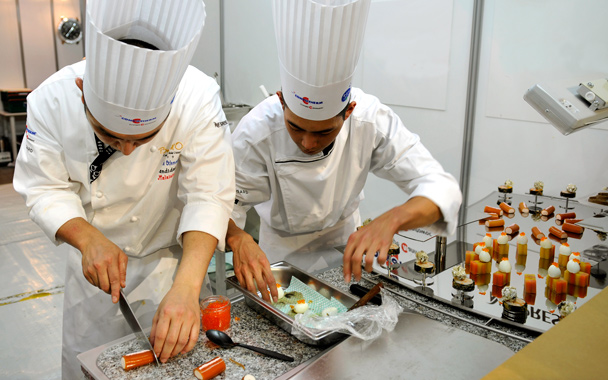This was supposed to be the year that America woke up to the Bocuse d’Or, the international cooking competition that ended last Wednesday in Lyon. We had a favored chef in the ring who was going to rectify America’s zero-medal record and expand the competition’s reach and notoriety to U.S. shores.
Contestants compete in teams that consist of a chef (who must be over the age of 23) and a commis (who must be younger than 22). They train for months, often giving up day jobs, to work out the menu and rehearse its preparation, which will be timed to the minute in a temporary electric kitchen of just over 190 square feet. Between the scrappy underdogs (South Africa) and the flashy dominators (France), the virtuoso displays of culinary skill, and the huge potential career impact for one of 24 talented young chefs, the Bocuse d’Or has serious personal and financial stakes.
I repeatedly forgot this fact as I watched the first day of the competition unfold in Lyon last Tuesday. I wonder if Americans will ever see it as more than a neon-lit, over-the-top Eurohilarity. The term “Olympics of cooking” ricochets around the stadium, but other metaphors for the event spring to mind: Miss Universe, Iron Chef, WWF, a rave, and a 3 A.M. infomercial.
The competition stadium sits at the center of a concurrent, massive trade show—a two-day, 2000-vendor blowout for the restaurant and hotel industry. This means that access to the stadium involves a dizzying tour through radial rows of fake restaurants, sham bars, cardboard lobbies, and disposable cafés. At one point, like a dumb mallard romancing decoys, I really wanted a coffee and sidled up to several convincing-looking espresso bars that in fact only served pamphlets on foam. The scale of this trade show might be succinctly suggested by the presence of both a stuffed-kittens-in-a-basket vendor AND Limoges porcelain.
The cooking begins at 8:50 A.M., at which point fans are already issuing periodic cheers from the row of bleachers that faces the row of kitchens, separated, portentously, by the judges’ banquet table. The kitchens are silent, busy, sterile hives, while the bleachers, as the day goes on, become ever more an unpredictable riot. If noise had gravity, the stadium would capsize in a second. When the Korean chef lifted his head from breaking down a three-foot-long Norwegian cod (one of the sponsored, mandatory ingredients) five air horns exploded in the Korean section. As the Swiss chef prepared to plate his first dish, out of nowhere a band of Swiss folk musicians stood up to bellow mournful chords from ten-foot trumpets (just like the ones in the Ricola commercials). And then there were the Finns. Over the years I have spent a good deal of time with Finns, my mother being one, and I tend to think of them as voluntarily non-vocal people—the kind who, were they to see my hair catch fire, would immediately email me about it. So to see 75 of them open-throat screaming for five hours was, frankly, thrilling.
Meanwhile, the competition’s theme song, which sounded like the musical accompaniment in a Telemundo soap opera when a prostitute kills a sorcerer, thumped in an incessant loop. Above this racket, an Entertainment-Tonight-style duo put on a floor show from about 10:30 until the end of the day. Angela, a giggle-prone American with teeth whiter than a blank computer monitor, bantered with Vincent, a barb-prone Frenchman with an inspector’s moustache. Sometimes they worked in harmony:
Angela: These truffles are so fresh.
Vincent: Did you know truffles cost half this year what they did last year?
Angela: OOOOOOOOH!
And sometimes they hit rough patches:




 Pinterest
Pinterest


